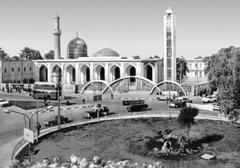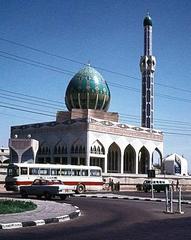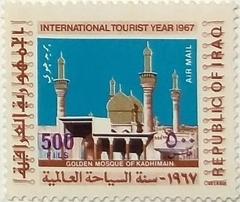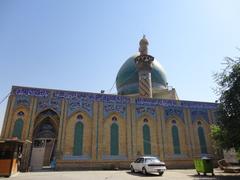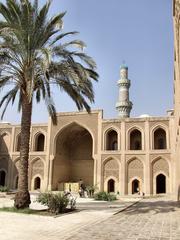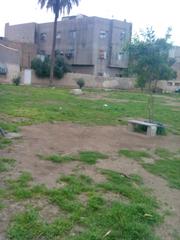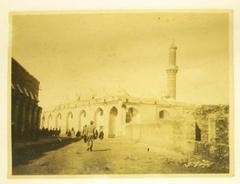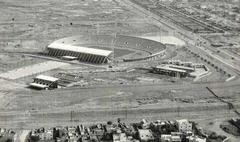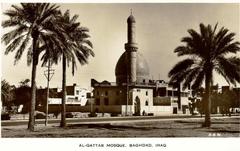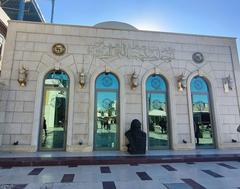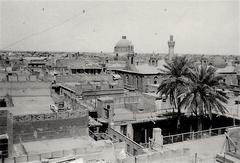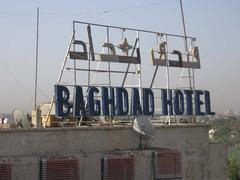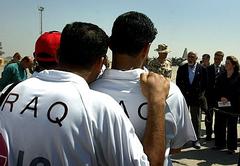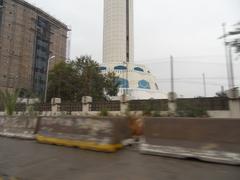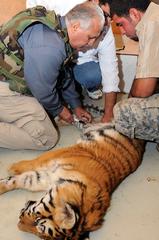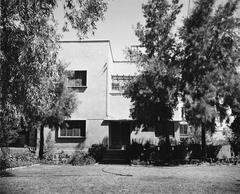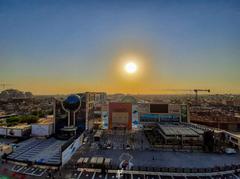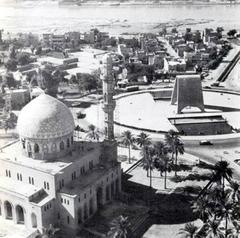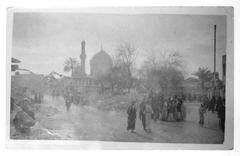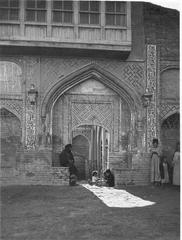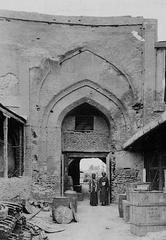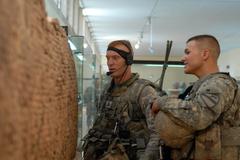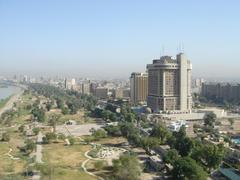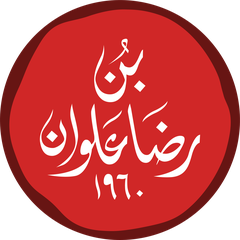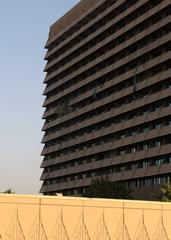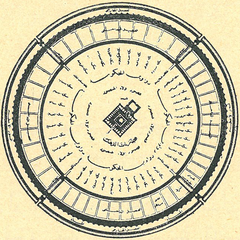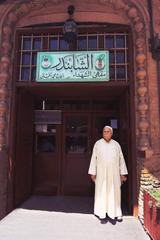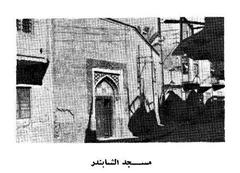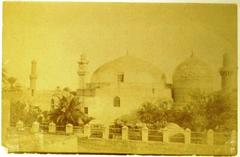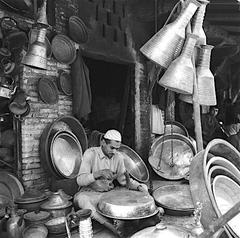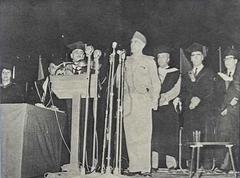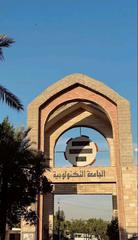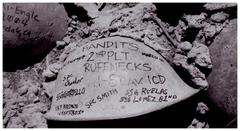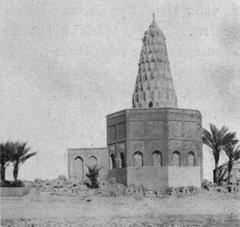
Baghdad Railway Station: Visiting Hours, Tickets, and Visitor Guide
Date: 04/07/2025
Introduction
Baghdad Central Station, also known as Baghdad Railway Station, stands as a testament to Iraq’s layered history, architectural splendor, and cultural resilience. Established in the early 1950s as part of the Berlin–Baghdad railway project, the station blends British architectural elements with traditional Iraqi motifs. Its iconic turquoise dome, twin clock towers, and grand main hall reflect Iraq’s mid-20th-century aspirations to serve as a crossroads between East and West (Andrew Grantham; Designed in Iraq; BBC News).
Despite turbulent decades marked by conflict and decline, Baghdad Central Station endures as a vital, if reduced, transport hub and a symbol of national pride. This guide provides detailed information for visitors, including the station’s history, architectural features, visiting hours, ticketing, accessibility, safety considerations, and nearby attractions.
Table of Contents
- Overview and Historical Significance
- Architectural Design and Features
- The Evolution of Baghdad Railways
- Modern Operations and Visitor Experience
- Visiting Hours, Tickets, and Accessibility
- Nearby Attractions
- Safety and Practical Tips
- Frequently Asked Questions (FAQ)
- Conclusion
- Sources
Overview and Historical Significance
Baghdad Central Station’s origins are rooted in the early 20th century with the Berlin–Baghdad railway, a project that sought to link Europe and the Persian Gulf for both strategic and commercial purposes (Andrew Grantham). After World War I, British authorities accelerated railway construction to facilitate military logistics. The station eventually became the heart of Iraq’s rail network, symbolizing the nation’s modernization and cosmopolitan identity.
Over the decades, the station witnessed Iraq’s golden age of railway travel, periods of decline, and episodes of renewal—most notably following extensive damage and looting after the 2003 invasion. Its continued restoration underscores its importance in Iraq’s cultural and civic landscape (BBC News; Designed in Iraq).
Architectural Design and Features
Baghdad Central Station was completed in the early 1950s, designed by British architect J. M. Wilson. The building’s monumental form and turquoise dome evoke both British and Islamic architectural traditions. Key features include:
- Twin Clock Towers: One displays English numerals, the other Indo-Arabic, symbolizing the station’s cross-cultural heritage.
- Grand Main Hall: High ceilings, arched windows, and geometric tilework create a bright, welcoming space (Designed in Iraq).
- Urban Context: Located on Qahira Street near the Green Zone, the station was built as a symbol of national progress, though later urban development somewhat isolated it.
Inside, original brickwork, decorative motifs, and functional layouts for ticketing and waiting areas remain, despite modern refurbishments. The station’s architectural grandeur is an enduring point of civic pride.
The Evolution of Baghdad Railways
The Golden Age
In the mid-20th century, Baghdad Central Station thrived as a hub connecting Baghdad to cities such as Istanbul, Damascus, and even London. Presidential carriages, luxury trains, and bustling platforms highlighted Iraq’s role as a regional crossroads (BBC News).
Decline and Renovation
Decades of political instability, sanctions, and conflict led to operational decline. The once-vast train fleet dwindled, and the station suffered damage during the 2003 invasion. Restoration efforts since then have focused on reviving both infrastructure and the station’s historical character (Andrew Grantham; Dewan Award).
Modern Operations and Visitor Experience
Location and Layout
The station is centrally located in the Al-Karkh district, near the Tigris River and accessible via Qahira Street (FlySepehran). Facilities include:
- A spacious main hall with restored tilework
- Ticket counters and waiting areas
- Modern restrooms and a small on-site hotel (13 rooms)
- Restaurant and kiosks for snacks and essentials
- A display of historical railway artifacts, including a 1914 Borsig steam locomotive (Andrew Grantham)
Train Services
- Main Route: Baghdad–Basra (overnight; journey time: 10–12 hours)
- Other Routes: Occasional trains to Karbala, Mosul, and Samarra, subject to operational and security changes (Seat61; rail.cc)
Ticketing
- Purchase: Tickets are available at station counters; cash in Iraqi dinars is preferred.
- Fares: Baghdad–Basra fares typically range from $7–20 USD, depending on class.
- Booking: Advance purchase is advised during busy periods and festivals (Tourist Secrets).
Visiting Hours, Tickets, and Accessibility
- Visiting Hours: Daily, 6:00 AM–10:00 PM. Hours may vary during public holidays or special events; confirm locally (FlySepehran).
- Accessibility: Ramps and accessible restrooms exist, but certain areas may be challenging due to the station’s historic structure.
- Language: Arabic is predominant; limited English spoken. Translation apps are recommended.
Travel Tips:
- Arrive 30–45 minutes before departure for security checks and boarding.
- Bring cash (small bills) and valid identification.
- Dress modestly, respect local customs, and be mindful of security personnel and protocols.
Nearby Attractions
Baghdad Central Station’s location makes it a convenient starting point for exploring the city’s heritage. Notable sites include:
- National Museum of Iraq: Archaeological and cultural treasures
- Al-Mustansiriya Madrasah: Historic Abbasid-era educational institution
- Abbasid Palace: Remnant of Baghdad’s medieval past
- Al-Mutanabbi Street: Famous for bookshops and literary cafes
- Martyrs Monument (Al-Shaheed Monument): Symbolic national landmark
Taxi or ride-sharing apps are the most convenient means of reaching these attractions (Beyond the Bucket List).
Safety and Practical Tips
Security is rigorous, with multiple screening layers and visible military presence (Against the Compass; Xplrverse). Carry your passport and visa at all times, comply with inspections, and avoid photographing security staff or sensitive areas. While safety in Baghdad has improved, remain vigilant and avoid traveling after dark. Consult your government’s travel advisories and register with your embassy if required (Traveler Bibles).
Frequently Asked Questions (FAQ)
Q: What are the station’s opening hours?
A: Typically, 6:00 AM–10:00 PM daily; check locally for variations.
Q: How do I buy tickets?
A: At the station ticket counters (cash only); advance purchase is recommended.
Q: Is the station accessible for travelers with disabilities?
A: Partially; some ramps and accessible restrooms, but certain areas may be difficult to navigate.
Q: Is English spoken at the station?
A: English is limited; Arabic predominates. Use translation apps or consider a guide.
Q: Are there guided tours or special events?
A: Occasionally, cultural events or tours are offered; check at the station or with local operators.
Q: Is photography allowed?
A: Generally yes in public areas, but avoid photographing security personnel or equipment.
Conclusion
Baghdad Central Station is both a historic icon and a living testament to Iraq’s enduring spirit. Whether you are an architecture enthusiast, history buff, or traveler, the station offers a window into Baghdad’s storied past and hopeful future. Plan your visit by checking current schedules, allowing extra time for security, and exploring nearby cultural sites. For up-to-date information, download the Audiala app and follow our resources for the latest travel advice.
Sources
- Andrew Grantham – Iraq Railway History
- Designed in Iraq – Baghdad Central Station Entry
- BBC News – Baghdad Central Station History and Photography
- Dewan Award – Baghdad Railway Station
- FlySepehran – Baghdad Travel Guide
- Andrew Grantham – Station Refurbishment
- Seat61 – Iraq Train Travel
- rail.cc – Baghdad Station
- Tourist Secrets – Baghdad Train Travel
- Beyond the Bucket List – Iraq Itinerary
- Against the Compass – Iraq Travel Guide
- Xplrverse – Is Iraq Safe for Travelers?
- Traveler Bibles – Visiting Baghdad
- Dewan Award – Station Competition








